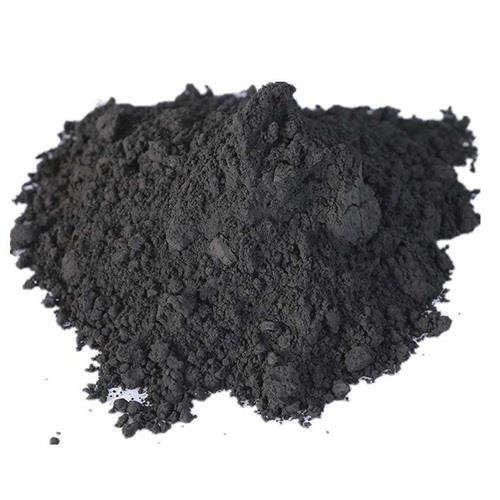| Identification | More | [Name]
Cobalt oxide | [CAS]
1307-96-6 | [Synonyms]
COBALT(II) OXIDE
COBALT MONOXIDE
COBALTOUS (II) OXIDE
COBALTOUS MONOXIDE
COBALTOUS OXIDE
COBALT OXIDE
C.I. 77322
C.I. Pigment black 13
c.i.77322
c.i.pigmentblack13
ci77322
cipigmentblack13
Cobalt monooxide
Cobalt oxide (CoO)
Cobalt(2+) oxide
cobalt(2+)oxide
cobaltmonooxide
cobaltoxide(coo)
CoO
Monocobalt oxide | [EINECS(EC#)]
215-154-6 | [Molecular Formula]
CoO | [MDL Number]
MFCD00016031 | [Molecular Weight]
74.93 | [MOL File]
1307-96-6.mol |
| Chemical Properties | Back Directory | [Appearance]
Black powder | [Melting point ]
1785 °C | [bulk density]
0.966g/cm3 | [density ]
6.45 | [vapor pressure ]
0Pa@20°C | [solubility ]
insoluble in H2O; soluble in acid solutions | [form ]
Powder | [color ]
Green-brown | [Specific Gravity]
6.45 | [Stability:]
Stability Stable, but may be moisture sensitive. | [Water Solubility ]
insoluble | [Crystal Structure]
NaCl type | [Sensitive ]
Air Sensitive | [crystal system]
Cube | [Merck ]
14,2446 | [Space group]
Fm3m | [Lattice constant]
| a/nm | b/nm | c/nm | α/o | β/o | γ/o | V/nm3 | | 0.4263 | 0.4263 | 0.4263 | 90 | 90 | 90 | 0.0775 |
| [Exposure limits]
ACGIH: TWA 1 mg/m3
OSHA: TWA 15 mg/m3; TWA 5 mg/m3 | [InChI]
InChI=1S/Co.O | [InChIKey]
IVMYJDGYRUAWML-UHFFFAOYSA-N | [SMILES]
O=[Co] | [CAS DataBase Reference]
1307-96-6(CAS DataBase Reference) | [NIST Chemistry Reference]
Cobalt monoxide(1307-96-6) | [EPA Substance Registry System]
1307-96-6(EPA Substance) |
| Safety Data | Back Directory | [Hazard Codes ]
Xn,N | [Risk Statements ]
R22:Harmful if swallowed.
R43:May cause sensitization by skin contact.
R50/53:Very Toxic to aquatic organisms, may cause long-term adverse effects in the aquatic environment . | [Safety Statements ]
S24:Avoid contact with skin .
S37:Wear suitable gloves .
S60:This material and/or its container must be disposed of as hazardous waste .
S61:Avoid release to the environment. Refer to special instructions safety data sheet . | [RIDADR ]
UN 3288 6.1/PG 3
| [WGK Germany ]
3
| [RTECS ]
GG2800000
| [TSCA ]
Yes | [HazardClass ]
6.1(b) | [PackingGroup ]
III | [HS Code ]
28220000 | [Hazardous Substances Data]
1307-96-6(Hazardous Substances Data) |
| Questions And Answer | Back Directory | [Cobalt oxides]
Cobalt oxides have three oxidation states, namely: (i) cobaltous oxide (cobalt monoxide or cobalt [II] oxide) with CoO chemical formula, (ii) cobaltic oxide (cobalt [III] oxide) with Co2O3 chemical formula and (iii) cobaltosic oxide (cobalt [II, III] oxide) with Co3O4 chemical formula, which is an antiferromagnetic material. The first and the last oxidation states have a cubic crystal structure.
Cobalt oxide is used in pigments for ceramics, in glass coloring and decolorization, as oxidation catalyst for drying oils, and fast-drying paints and varnishes, in preparation of cobalt-metal catalysts, and cobalt powder for binder in sintered tungsten carbide; in semiconductors. | [Uses]
Cobalt(II) oxide is used as a pigment for ceramics and paints; for drying paints, varnishes and oils; for coloring glass; as a catalyst; and for preparation of other cobalt salts. The commercial product is a mixture of cobalt oxides.
| [Preparation]
Cobalt(II) oxide is prepared by heating cobalt(II) carbonate, CoCO3, cobalt(III) oxide, Co2O3 or tricobalt tetroxide, Co3O4, at high temperatures in a neutral or slightly reducing atmosphere:
CoCO3 → CoO + CO2
| [Toxicity]
Cobalt(II) oxide is moderately toxic by ingestion and subcutaneous and intratracheal routes.
LD50 oral (rat): 202 mg/kg
|
| Hazard Information | Back Directory | [Description]
This is obtained as an olive-green powder by heating the metal in air or steam or by thermal decomposition of the hydroxide, carbonate or nitrate. It has the sodium chloride lattice and is antiferromagnetic below 292°K. When heated in oxygen above 400° the black oxide Co3O4 is obtained. This oxide is isomorphous with magnetite Fe3O4, and has tetrahedrally surrounded cobalt(II) ions and octahedrally surrounded cobalt(III) ions. Both these oxides are readily reduced to the metal by heating in hydrogen or with carbon. The reactions of CoO with silica, alumina and zinc oxide are used to form pigments in the ceramic industry. | [Chemical Properties]
Cobalt oxide is a high-valent oxide of cobalt, with a theoretical cobalt content of 71.06% and an oxygen content of 28.94%, which is a black amorphous powder. Cobalt oxide is a kind of unstable and impossible free state compound, usually refers to the cobalt oxide are attached with a certain amount of cobalt tetraoxide when heated cobalt oxide is reduced to cobalt tetraoxide. The theoretical cobalt content of cobalt tetraoxide is 73.43% and the oxygen content is 26.57%, with the appearance of gray-black or black powder.

The cobalt oxide used in batteries is cobalt tetraoxide, which has a spinel structure. It can be used as anode material for lithium-ion batteries and is also the main raw material for the preparation of lithium cobaltate, the cathode material for lithium-ion batteries. | [Physical properties]
The commercial product is usually dark grey powder, but the color may vary from olive geeen to brown depending on particle size; density 6.44 g/cm3, which also may vary between 5.7 to 6.7 g/cm3, depending on the method of preparation; melts around 1,830°C; insoluble in water; soluble in acids and alkalis. | [Flammability and Explosibility]
Notclassified(100%) | [Structure and conformation]
Green cobalt(II) oxide (CoO) has the rock salt (NaCl) structure. It is easily oxidized with water and oxygen to brown cobalt(III) hydroxide (Co(OH)3). At temperatures of 600℃-700℃, CoO oxidizes to the blue cobalt (II,III) oxide (Co3O4), which has a spinel structure. Black cobalt(III) oxide (Co2O3) also exists. Cobalt oxides are antiferromagnetic at low temperature: CoO (Ne′el temperature 18℃/291K) and Co3O4 (Ne′el temperature: 2233℃/40K), which is analogous to magnetite (Fe3O4), with a mixture of 12 and 13 oxidation states. |
|
|